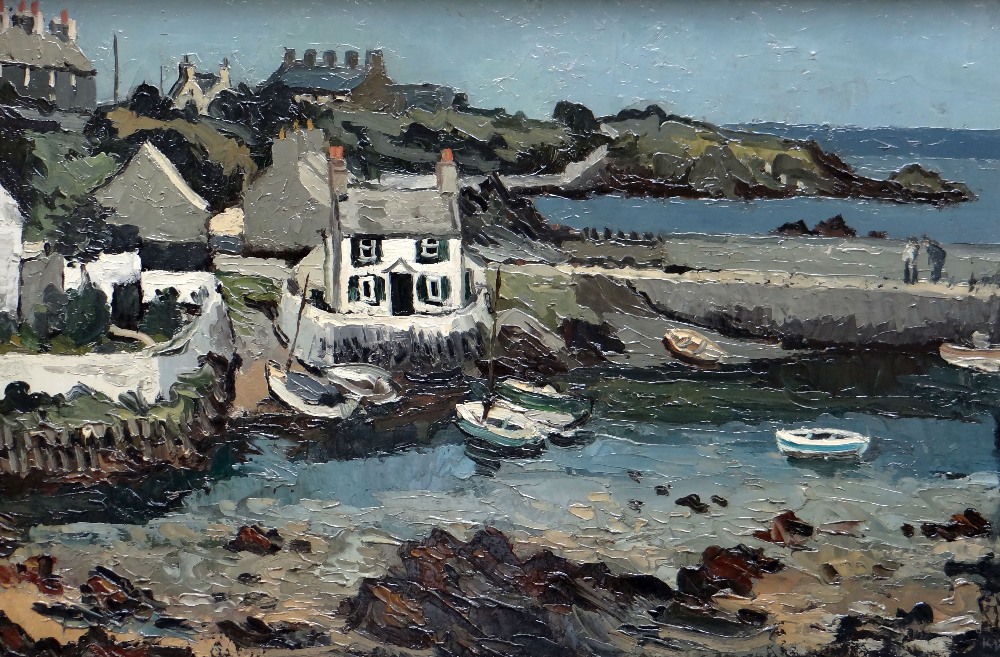24 x 36" (sight), signed lower right "Daly 1805 or 1895." With an additional, later pencilled notation at the lower left "Chicago River at Lake M. Kinsey. Old Settler's house. Arnolds." An intriguing painting of this important Midwestern fort, erected in 1803 of lands ceded to the U.S. Government at the Treaty of Greenville. Fort Dearborn, built near the mouth of the Chicago River, lay at the juncture of portage trails leading to the Mississippin and Illinois River drainages. During the War of 1812 it's strategic location was not lost on the British and their allies. On August 15, 1812 a party of Pottawatomie and Ottawa Indians lead by Chief Blackbird ambushed the occupants of the fort, killng more than 50 of the 96 total inhabitants, and afterwards buring the fort to the ground. The Fort was rebuilt in 1816, only to be closed permanently in 1837, when the remaining buildings were taken offer by the Superintendent of Harbor Works. The present painting shows Fort Dearborn in its earliest period, with its stockaded compound on the right, and the cabin of John Kinzie, the first permanent American settler of the Chicago area on the right. An Indian in a birch-bark canoe paddles towards a distant camp of wigwams, typical of the bark covered structures of Great Lakes native Americans. The painting is similar, if not identical to one been accomplished by Royal H. Milleson in 1894 and currently in the collection of the Chicago Historical Society. Milleson (1849-1935) is best known as an newspaper cartoonist and illustrator. He lived much of his life in Indianapolis, Indiana, though from ca. 1900-1923 resided in Chicago; he died in Evanston, Illinois. We suspect that this painting was copied from Milleson's work; both the stretcher style, and canvas type are consistent with this determination, and it is housed in a large, ornate frame typical of the period. This painting has descended through the Gutting family of Ottawa, Illinois, and is accompanied by a copy of a 1962 photograph showing the painting in the home, along with a letter from Betty Morris Gutting, telling of the history of the painting. Condition:Painting is untouched. Other than several white paint "drips" on the canvas, it is unblemished, though in need of cleaning.
24 x 36" (sight), signed lower right "Daly 1805 or 1895." With an additional, later pencilled notation at the lower left "Chicago River at Lake M. Kinsey. Old Settler's house. Arnolds." An intriguing painting of this important Midwestern fort, erected in 1803 of lands ceded to the U.S. Government at the Treaty of Greenville. Fort Dearborn, built near the mouth of the Chicago River, lay at the juncture of portage trails leading to the Mississippin and Illinois River drainages. During the War of 1812 it's strategic location was not lost on the British and their allies. On August 15, 1812 a party of Pottawatomie and Ottawa Indians lead by Chief Blackbird ambushed the occupants of the fort, killng more than 50 of the 96 total inhabitants, and afterwards buring the fort to the ground. The Fort was rebuilt in 1816, only to be closed permanently in 1837, when the remaining buildings were taken offer by the Superintendent of Harbor Works. The present painting shows Fort Dearborn in its earliest period, with its stockaded compound on the right, and the cabin of John Kinzie, the first permanent American settler of the Chicago area on the right. An Indian in a birch-bark canoe paddles towards a distant camp of wigwams, typical of the bark covered structures of Great Lakes native Americans. The painting is similar, if not identical to one been accomplished by Royal H. Milleson in 1894 and currently in the collection of the Chicago Historical Society. Milleson (1849-1935) is best known as an newspaper cartoonist and illustrator. He lived much of his life in Indianapolis, Indiana, though from ca. 1900-1923 resided in Chicago; he died in Evanston, Illinois. We suspect that this painting was copied from Milleson's work; both the stretcher style, and canvas type are consistent with this determination, and it is housed in a large, ornate frame typical of the period. This painting has descended through the Gutting family of Ottawa, Illinois, and is accompanied by a copy of a 1962 photograph showing the painting in the home, along with a letter from Betty Morris Gutting, telling of the history of the painting. Condition:Painting is untouched. Other than several white paint "drips" on the canvas, it is unblemished, though in need of cleaning.















Testen Sie LotSearch und seine Premium-Features 7 Tage - ohne Kosten!
Lassen Sie sich automatisch über neue Objekte in kommenden Auktionen benachrichtigen.
Suchauftrag anlegen